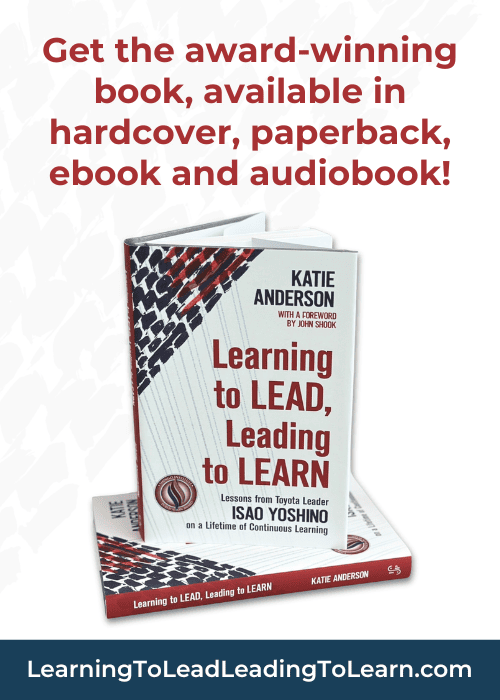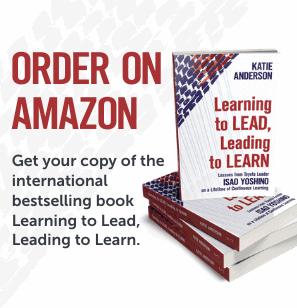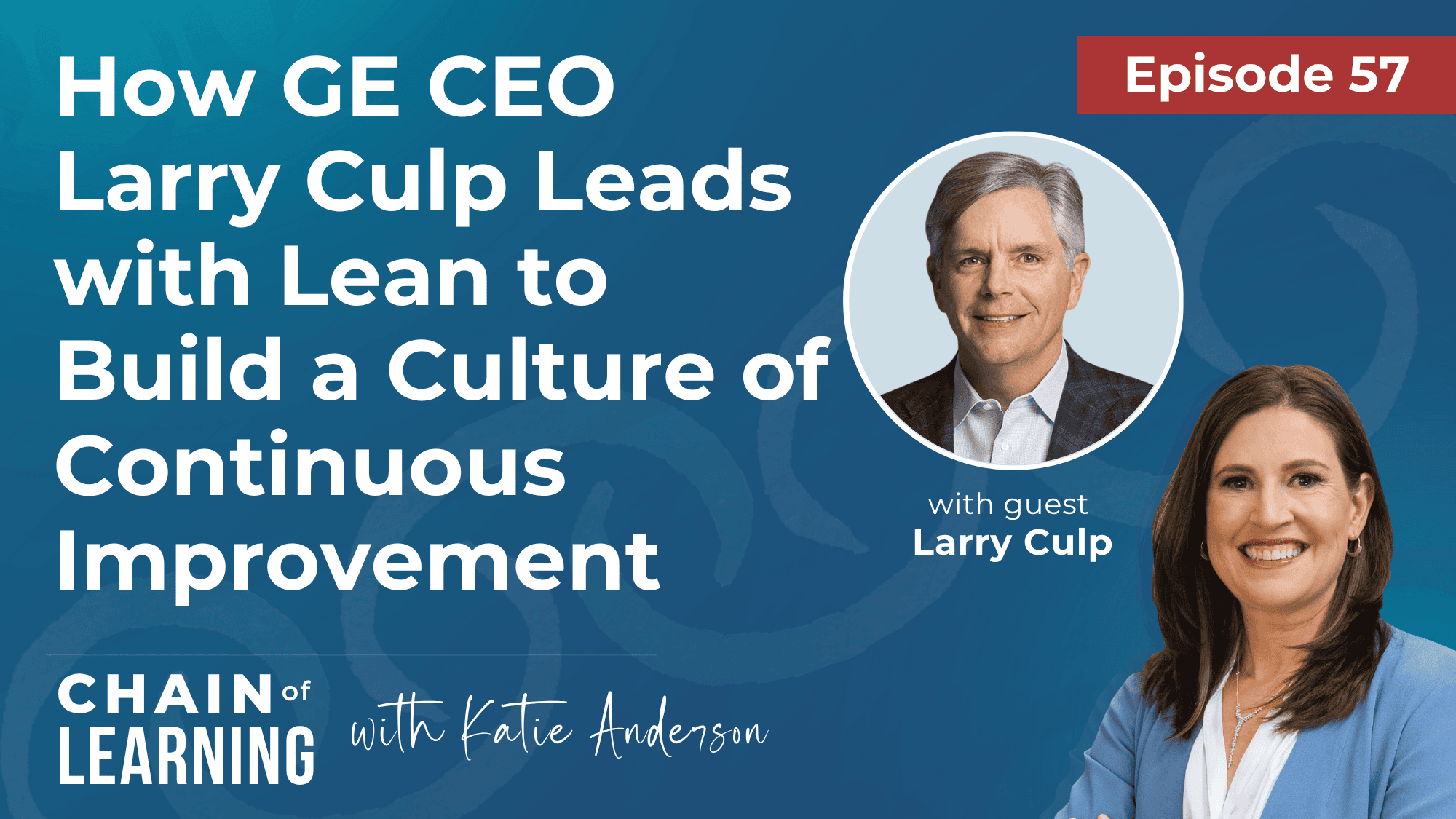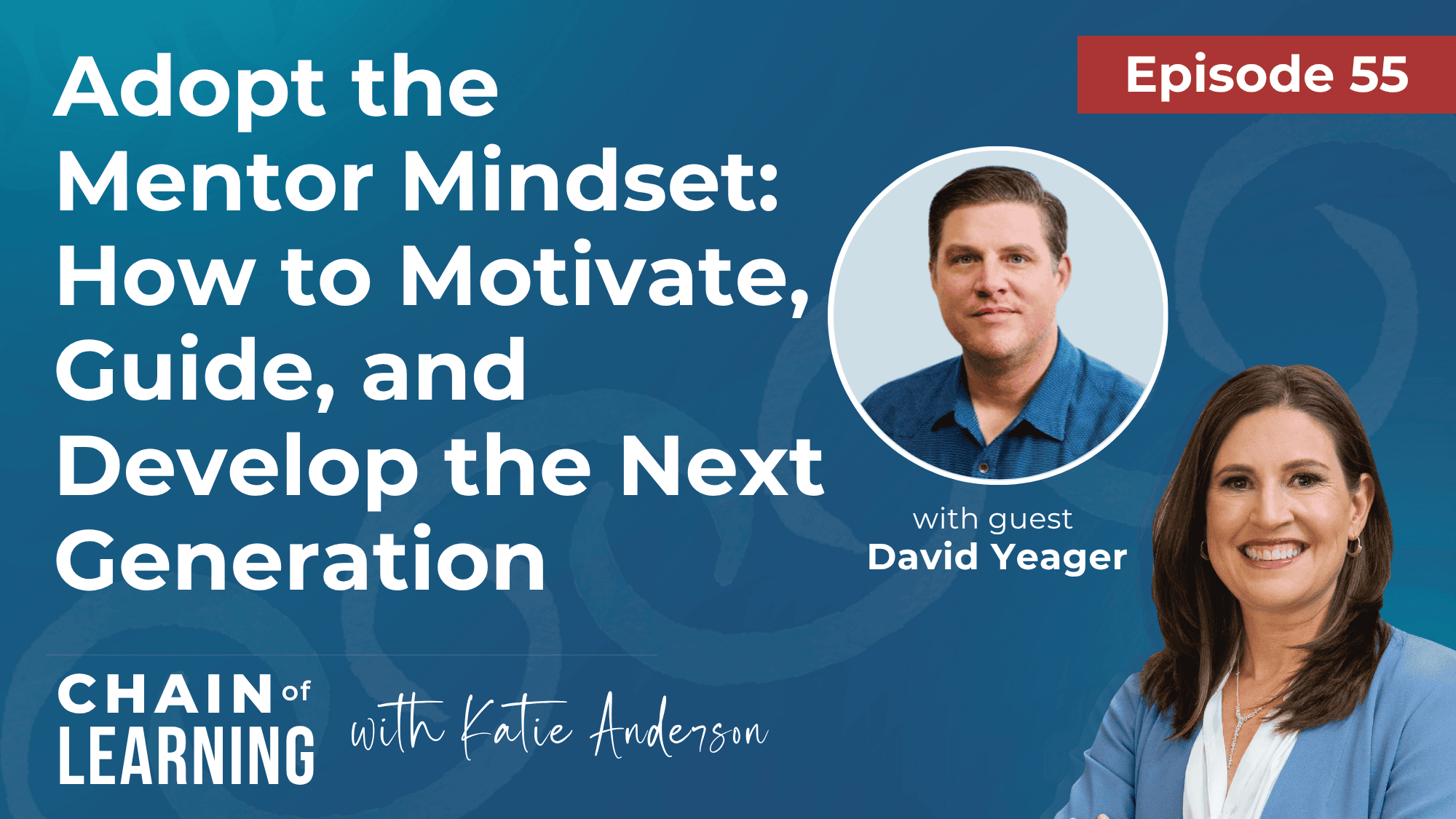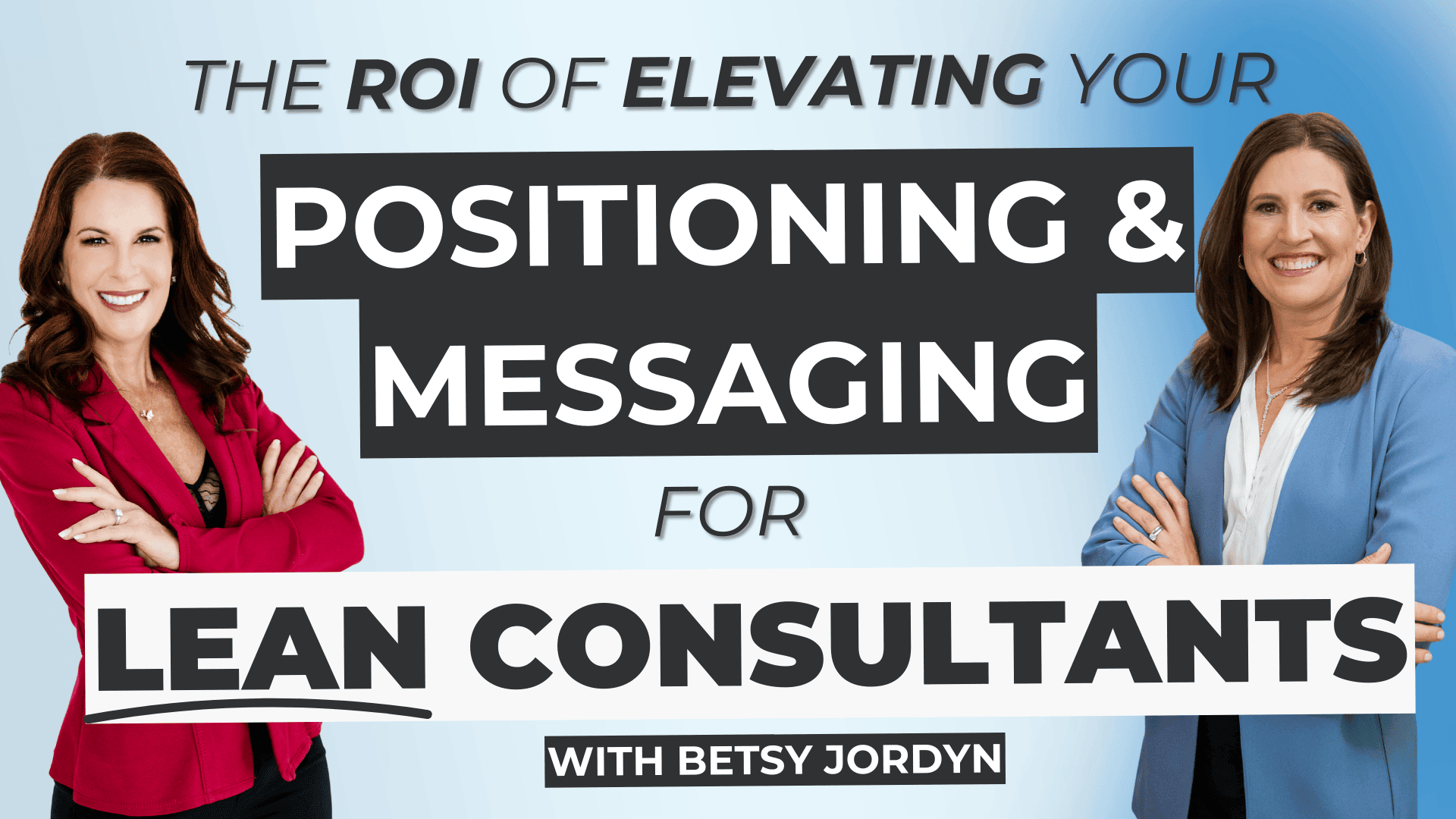As leaders and continuous improvement practitioners, we’re committed to creating a people-centered learning organization. But how? Most importantly, by creating the right culture – one that is connected through systems and human behavior. Culture is the accumulation of learned and accepted patterns of behavior, within a system, that can either be intentionally created through thoughtful direction by leaders, or unintentionally the result of unchecked and allowed behavior.
I’ve put together this article with some of my top books on how to build an intentional lean culture, lead transformational organizational change, and develop (and deploy) strategy.
I’m often asked for my top book recommendations on a host of topics and I’ve decided to pull together several posts sharing some of my “go-to” books that have influenced me personally as a leader and coach of organizational change, developing a people-centered learning culture, and creating a lean management system.
While this is not a conclusive list of my best books about learning cultures (they’re 10 top books rather than my top 10) – all are go-to recommendations for anyone seeking to lead transformational culture change and create a culture of learning. They each have influenced me personally as a leader of organizational change, in how to develop a people-centered learning culture, and the foundations of a lean management system.
This list is the third in a three-part series that shares some of my top book recommendations broken down into three categories. Be sure to check them all out:
- 10 Top Books on Lean Management, Lean Production, and Toyota History
- 10 Top Books on Coaching and Problem-Solving
- 10 Top Books on Culture, Organizational Change, and Strategy (this post)
Top Books on Lean Culture, Organizational Change, and Strategy
This article focuses on some of my top books on culture, organizational change, and strategy, that can help you lead organizational change, develop and deploy strategy, and discover what it means to be a leader or coach in creating a lean learning organization culture.
There are so many on my shelves that have influenced my personal practice of how to develop a learning organization or practice lean thinking that it was hard to get this list down to just ten books.
So, in order to narrow it down, I am first sharing influential books from authors in my own learning journey, who have also honored my book Learning to Lead, Leading to Learn with their endorsement, plus a few bonus books as well.
Here you’ll learn about why I recommend these 10 books on culture, organizational change, and strategy, as well as my personal experiences with many of these leading thinkers, and how they’ve informed my Chain of Learning.
There are many more books I could include on this list, but these are some of my go-to books that I suggest if you are a lean practitioner or anyone seeking to understand the real success to create a real learning organization that is leader led, people-focused, and strategically aligned.
Without further ado, and in no particular order, here are 10 of my top books on culture, organizational change, and strategy to create a robust lean management system.
Learning to Lead, Leading to Learn
 I’m including my own book Learning to Lead, Leading to Learn: Lessons from Toyota leader Isao Yoshino on a Lifetime of Continuous Learning, on this list as I learned so much about strategy deployment, leading organizational change, and creating a learning culture through my years of conversation with 40-year Toyota leader Isao Yoshino. Through the book, I attempt to capture insights and shared wisdom between Mr. Yoshino and me about how we all can develop to become leaders (either informally or formally with a management or executive position)….and to lead with an attitude towards learning. Isao Yoshino’s four decades at Toyota shows us the power of “leader as coach” and demonstrates – through his experiences and reflections on key moments in Toyota’s history – how leaders can create a learning culture.
I’m including my own book Learning to Lead, Leading to Learn: Lessons from Toyota leader Isao Yoshino on a Lifetime of Continuous Learning, on this list as I learned so much about strategy deployment, leading organizational change, and creating a learning culture through my years of conversation with 40-year Toyota leader Isao Yoshino. Through the book, I attempt to capture insights and shared wisdom between Mr. Yoshino and me about how we all can develop to become leaders (either informally or formally with a management or executive position)….and to lead with an attitude towards learning. Isao Yoshino’s four decades at Toyota shows us the power of “leader as coach” and demonstrates – through his experiences and reflections on key moments in Toyota’s history – how leaders can create a learning culture.
But don’t just take my word for it about the impact of Learning to Lead, Leading to Learn! Below you can read what these other influential authors had to say about their learning from the book.
Joy, Inc. and Chief Joy Officer by Richard Sheridan
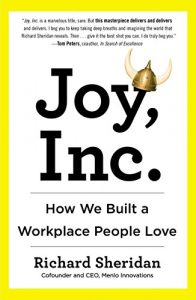 CEO and Chief Storyteller at Menlo Innovations
CEO and Chief Storyteller at Menlo Innovations
I had the pleasure of first meeting Rich Sheridan at the very same event where I first met Isao Yoshino – the Lean Coaching Summit in Long Beach, California, in July 2014. I was captivated by Rich’s storytelling and leadership passion then, and that’s only grown since I’ve gotten to personally know him.
Rich provided me with support and encouragement to cross the finish line with my book Learning to Lead, Leading to Learn. We had the joy of sitting together at dinner one night while attending the Association for Manufacturing Excellence conference in October 2019, the same time period in which I was working on the final “first draft” of my book.
His words then, and follow-up emails of support over the next year, were invaluable as I finished and ultimately published the book in the midst of the early months of a global pandemic.
I’ve enjoyed both of Rich’s books, Joy, Inc. and Chief Joy Officer, but Joy Inc. is my go-to book for how to build a workplace culture founded on joy, people, and learning.
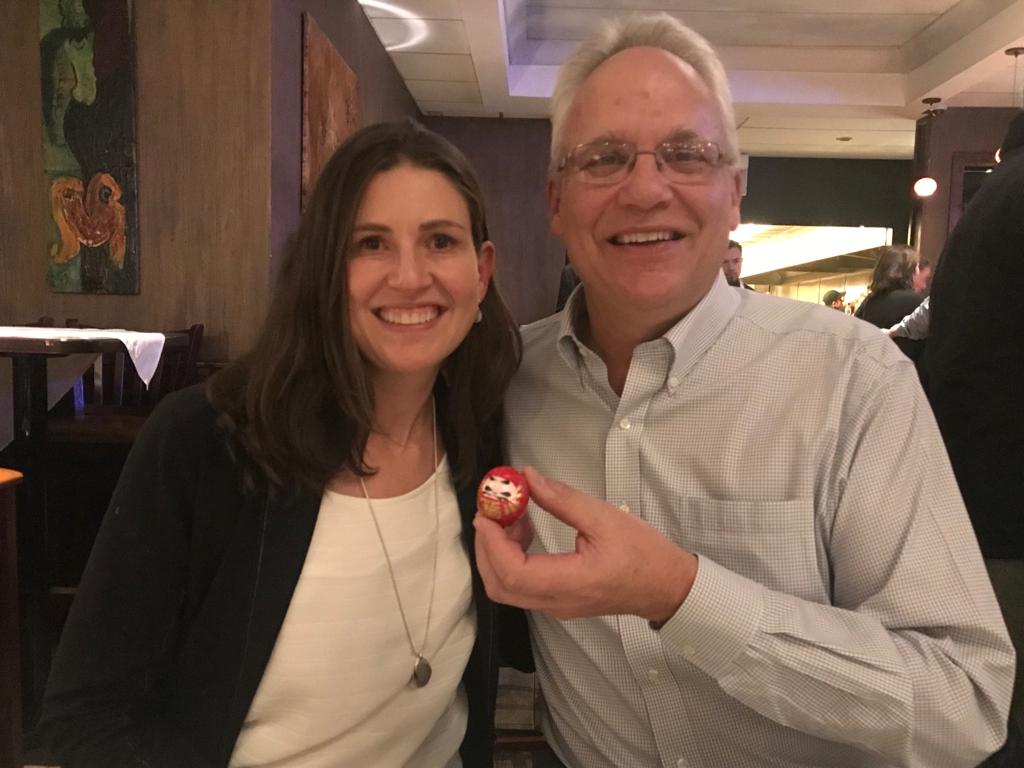
Here’s what Rich Sheridan has to say about Learning to Lead, Leading to Learn:
“If leadership, lean, systems thinking, continuous improvement, company culture, learning, or storytelling bring you joy as they do me, you must BUY this book. If you are seeking the next step on your own journey of transformational leadership, then you must READ this book. If you want to become the leader you always knew you could be, then you must LIVE the lessons in this book. Thank you, Katie and Mr Yoshino for your efforts and your results. The immortality gained from Learning to Lead, Leading to Learn will benefit generations to come.”
Joy, Inc: How We Built a Workplace People Love
From the Publisher:
CEO and Chief Storyteller Rich Sheridan removed the fear and ambiguity that typically make a workplace miserable. With joy as the explicit goal for Menlo’s staff, as well as their clients and the people who use the products they create, Sheridan and his team changed everything about how the company was run. Now he offers an inside look at a shared belief system that influences physical space, embraces making mistakes, and eliminates meetings—all while fostering dignity and respect for the team.
Joy, Inc. is for readers in any field who want tangible examples of a healthier, happier atmosphere at work—leading to the sustainable business results required for growth.
Clarity First by Karen Martin
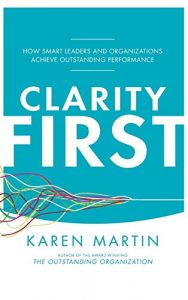 President TKMG, Inc. and Shingo Award-winning author
President TKMG, Inc. and Shingo Award-winning author
Karen Martin and I also first met at the Lean Coaching Summit in 2014, where I first met Mr. Yoshino. Karen is a powerhouse of thought leadership on learning organization culture and lean management – from the technical aspects of value stream mapping to the leadership behaviors and organizational structures needed to create a sustainable learning culture – and has been an incredible supporter of me as I published my first book Learning to Lead, Leading to Learn.
Since I first read it, Clarity First has been one of my most recommended books for business leaders seeking to deliver on business results through tapping into the creativity and human potential of their people. It’s a “lean management” book encapsulating the core principles of change management and lean without being a book specifically about lean. I highly recommend it for all leaders and coaches of continuous improvement and business transformation!
Here’s what Karen had to say about Learning to Lead, Leading to Learn:
“Wow! It’s rare for a business book to pack a punch the way Katie Anderson’s Learning to Lead, Leading to Learn does. Katie has produced a gem that illustrates — in the clearest way yet — what truly makes Toyota tick. She does so by weaving an inspiring biography (Mr. Yoshino’s personal and leadership journey) with practical lean leadership principles, and through thought-provoking, humility-laced stories versus a formulaic ‘10 Steps to Magnificence’! And she does so in the most humanistic way I’ve seen in a business book. An added benefit — and one I didn’t see coming — is that U.S. readers may feel a bit more patriotic by reading this gem — at a time when we most need it. Want to be a better leader, a better improvement professional, a better human being? Read this book!”
Karen Martin, Shingo Award-winning author
Clarity First: How Smart Leaders and Organizations Achieve Outstanding Performance
From the Publisher:
In Clarity First, Karen provides methods and insights for achieving clarity to unleash potential, innovate at higher levels, and solve the problems that matter to deliver outstanding business results. Both a visionary road map and practical guide, this book will help leaders:
- Identify and communicate the organization’s true purpose
- Set achievable priorities
- Deliver greater customer value through more efficient processes
- Build organization-wide problem-solving capabilities
- Develop personal clarity to become a more direct, purposeful, and successful leader
Eliminating ambiguity is the first step for leaders and organizations to achieve strategic goals. Learn how to gain the clarity needed to make better decisions, lead more effectively, and boost organizational performance.
The Elegant Solution by Matthew May
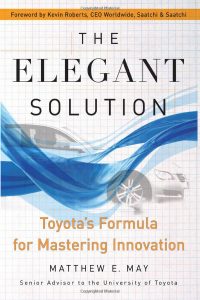 I first got introduced to Matthew May’s work through my colleague and friend Jeff Hunter (whose book on strategy is also on this list!) when he and I were both supporting strategy deployment and lean management systems in healthcare.
I first got introduced to Matthew May’s work through my colleague and friend Jeff Hunter (whose book on strategy is also on this list!) when he and I were both supporting strategy deployment and lean management systems in healthcare.
I became an instant fan of how Matt connects strategy, innovation, and leadership (and of course because he also loves darumas). Matt’s work in elaborating on the principles of what is now my “go to” strategy book Playing to Win by Lafley and Martin – see below in the “honorable mentions”), – and Matt’s experiences of directly working with Toyota for years, helping both Jeff and I in how we coached organizations in problem-solving strategy development and deployment.
Matt has published many books that I recommend, but The Elegant Solution is on this list as a top book in the culture and leadership behind Toyota’s successful learning culture and is a must-read for any leader of lean transformation and innovation.
I was thrilled when Matt – a Toyota insider – endorsed Learning to Lead, Leading to Learn.
Here’s what Matt had to say about Learning to Lead, Leading to Learn:
“I highly recommend Learning to Lead, Leading to Learn for anyone who is interested in Japanese business, Toyota’s unique corporate culture, and the Toyota way to lean leadership. Full of fascinating stories and wisdom, the book is also a wonderful example of cross-cultural and cross-generational collaboration and friendship.”
Matthew May, author, speaker, and executive coach
The Elegant Solution: Toyota’s Formula for Mastering Innovation
From the Publisher:
For the first time, an insider reveals the formula behind Toyota’s unceasing quest to innovate and do more with less, a philosophy that has made it one of the ten most profitable companies in the world (and worth more than GM, Ford, DaimlerChrysler, and Honda combined). In a rare look into Toyota’s ability to consistently achieve breakthroughs that outperform the competition, The Elegant Solution explains what Toyota associates have known all along: it’s not about the cars. Rather, Toyota’s astounding success is just the visible result of a hidden creative process that begins with a seven-digit number.
Building the Fit Organization by Daniel Markovitz
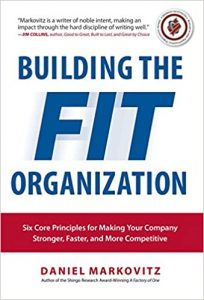 Founder of Markovitz Consulting and author of A Factory of One
Founder of Markovitz Consulting and author of A Factory of One
Dan Markovitz and I first got to know each other via my blog and social media when I was living in Japan in 2015. As a former Japan resident himself, Dan and I enjoyed sharing insights about learning Japanese, and sharing experiences about living and working in Japan.
We quickly discovered that our home-bases were both in the San Francisco Bay Area and, since 2016, regularly meet up in the city to grab a meal and talk about all things leadership, lean, Japan, and more.
Is your organization fit or flabby? That’s the provocative question that consultant, runner, and former Aasics employee Dan Markovitz asks in his book Building the Fit Organization: Six Core Principles for Making Your Company Stronger, Faster, and More Competitive. In the book, Dan demystifies the language of “lean” by describing the key principles of a change management system without using a lot of lean lingo or Japanese words. He shares tangible examples of how many organizations and leaders (including James Hereford, my former boss, who I’ve written about previously, and Rich Sheridan, whose book Joy, Inc. is also on this list) use these principles to develop organizational fitness and create a learning culture.
You can read my interview with Dan about Building the Fit Organization in this interview we did together when it was published.
I’ve also included another of Dan’s books, The Conclusion Trap, in my book recommendations about problem-solving and coaching for improvement. (forthcoming)!
Here’s what Dan had to say about Learning to Lead, Leading to Learn:
“Humans are hardwired to remember and learn from stories. Katie Anderson does the lean community a huge service by bringing storytelling to fundamental lean ideas through her interviews with Mr. Yoshino. Everyone will benefit from the depth and color that the book brings to otherwise dry disquisitions of the Toyota Way.”
Daniel Markovitz, author and consultant
From the Publisher:
Building the Fit Organization gives executives a distilled, jargon-free method for attaining the benefits of lean management under real-world conditions. The corporate landscape is littered with companies that have failed to achieve success by mirroring the Toyota Way, but this book distills the lessons from the Toyota Production System into six core concepts and presents them in the easily understandable language of physical fitness and athletic excellence.
You can easily create a dynamic, constantly improving, profoundly customer-focused organization with this revolutionary guide’s realistic game plan, complete with case studies and interviews highlighting how lean principles were used at actual companies as well as self-assessment checklists in each chapter for evaluating corporate “fitness” at any type of institution.
Becoming the Change by John Toussaint and Kim Barnas
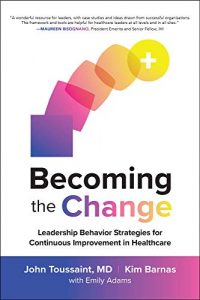 John is CEO emeritus of ThedaCare, and Kim is CEO of Catalysis
John is CEO emeritus of ThedaCare, and Kim is CEO of Catalysis
John Toussaint and the lean healthcare organization he founded – Catalysis (formerly the Thedacare Center for Healthcare Value) have been important parts of my lean leadership and coaching journey. I first met John around 2007 or 2008 when I was helping the hospital I worked for at the time get started with lean management. Both healthcare systems I worked for (Stanford and then Sutter Health) became part of the Catalysis network, and after starting my consulting practice, I partnered with Catalysis as a faculty member to teach leadership, coaching, and A3 thinking skills to healthcare executives.
John is not only an inspirational physician leader responsible for leading culture change in his own healthcare system as CEO, he created the network that has supported lean management culture changes across hundreds of healthcare organizations in North America and Europe. And he’s also a talented trumpet player who I’ve had the pleasure of listening to in some small bars in Appleton, Wisconsin and multiple Catalysis conferences!
John’s book, co-authored with current Catalysis CEO Kim Barnas, is a must read for anyone – regardless if they work in healthcare or another industry – seeking to lead organization change and establish a lean learning culture.
In Becoming the Change, Toussaint and Barnes reference the Personal Improvement A3, which I also teach and coach to in my practice with leaders. You can learn more about how to “become the change” through applying A3 thinking to personal improvement in a three-part series of articles starting here.
Here’s what John had to say about Learning to Lead, Leading to Learn:
“This book is an in-depth and personal look into the principles and actions of one of Toyota’s most admired leaders. All of us can learn from the many nuggets of wisdom Katie Anderson has distilled from interviews with Mr. Yoshino.”
John Toussaint, author and CEO
Becoming the Change: Leadership Behavior Strategies for Continuous Improvement in Healthcare
From the Publisher:
Two renowned experts in healthcare transformation show how leaders are implementing behavior-driven strategies to ensure quality care and create lasting change.
Healthcare is in the midst of a massive disruption. With financial structures in tatters and the future uncertain, this is the moment to begin the revolution. But first, leaders need to learn how to support staff at all levels as they make transformational improvements in care. This book demonstrates that real change is very personal and has to start at the top―whether you’re an executive, governing board member, manager, or physician.
Patient-Centered Strategy by Jeff Hunter
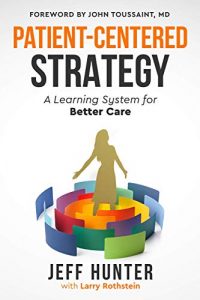 Healthcare leader in strategy formulation and strategy deployment
Healthcare leader in strategy formulation and strategy deployment
I met Jeff Hunter while I was working as the Director of the Lean Promotion Office at a large California ambulatory healthcare system and Jeff was the Vice-President of Strategy at Thedacare. He is the next author on my list of books on culture, organizational change, and strategy.
Shortly after starting my consulting practice in 2013, on a visit to Catalysis in Appleton, Wisconsin where I was starting a faculty, Jeff and I spent a few hours together talking about strategy development and deployment. It was then he introduced me to the work of Matt May (see above) and the book Playing to Win (see below).
Since then, Jeff and I have partnered regularly to discuss strategy and lean culture. Jeff came out to help me and my fellow members of the Board of Directors of the non-profit The Mother’s Milk Bank develop our strategy at our strategy retreat in February 2020 (one of the last in-person events I participated in before the pandemic).
I’m honored that Jeff has acknowledged me in Patient Centered Strategy as someone who has also influenced his thinking, and I’m honored for his endorsement of Learning to Lead, Leading to Learn. Be sure to check out my interview with Jeff about Patient Centered Strategy in this article.
While Jeff’s book uses healthcare as the context in which he talks about strategy development and deployment, this book is a great resource for leaders in any industry seeking to lead strategy and culture change, and to create a lean management system connected with strategy.
Here’s what Jeff had to say about Learning to Lead, Leading to Learn:
“As I reflect on my career as a leader, I wish I would have been more consistent and passionate at helping people develop their capability. I didn’t have the benefit of insights like you will discover in Learning to Lead, Leading to Learn. In this important exploration of Mr. Yoshino’s experience, Katie Anderson reveals the characteristics and behaviors of a leader who truly makes everyone around them better. Based on Mr. Yoshino’s career insights and her own leadership coaching expertise, Katie outlines a vital leadership framework of “setting the direction,” “providing support,” and “developing yourself” — and challenges us to lead and learn differently and more meaningfully. This book is a very practical guide to understanding what unlocks the potential of collaborators in an organization to dream, and to achieve their dreams through alignment of intention; and it’s a practical guide for anyone who wants to develop themselves into a better leader and a contributor to the greater good.”
Jeff Hunter, former Senior VP of Strategy and Marketing and author
Patient-Centered Strategy: A Learning System for Better Care
From the Publisher:
At a time of unprecedented healthcare industry turmoil and growing inroads by competitors from CVS to Amazon, hospital CEOs and senior leaders need an innovative, comprehensive approach to strategic thinking.
In Patient-Centered Strategy, Jeff Hunter, a leading healthcare strategic planner for more than 40 years, describes a powerful new system for strategy formulation one that derives value from an in depth understanding of patients needs, and unites senior leaders with frontline caregivers in the creative process.
Lead with Respect by Michael Ballé and Freddy Ballé
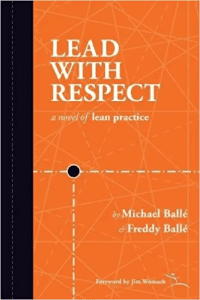 Co-authors of The Goal Mine and The Lean Manager
Co-authors of The Goal Mine and The Lean Manager
Onto the next of my books on culture, organizational change, and strategy. Michael Ballé has made innumerous contributions to the foundational body of knowledge about lean thinking and practice. While I typically prefer non-fiction books when it comes to management and leadership, Michael’s and his father Freddy’s books stand out due to their ability to connect lean principles and lean practices with relatable and tangible stories in their books. I chose Lead with Respect to be on this list because of its connection with the real power of lean – about developing people and leading with respect.
I interviewed Michael about another book he co-wrote – The Lean Strategy – which you can read here (Part 1 and Part 2.)
Here’s what Michael had to say about Learning to Lead, Leading to Learn:
“If you’re interested in lean and learning, this is an absolute must-read! Katie Anderson’s brilliant and original concept of warp (our deeper interests and goals) and weft (what we discover and learn in our journey) — illustrated through the real-life experience of Isao Yoshino, one of Toyota’s great sensei — makes a unique, pleasant, and illuminating read. Don’t miss it.”
Michael Ballé, author
Lead With Respect: A Novel of Lean Practice
From the Publisher:
In their new business novel Lead With Respect, authors Michael and Freddy Ballé reveal the true power of lean: developing people through a rigorous application of proven tools and methods. And, in the process, creating the only sustainable source of competitive advantage—a culture of continuous improvement.
Lead With Respect’s timely message brings a new understanding of lean. While lean has become essential for companies to compete in today’s global economy, most practitioners see it as a rigorous focus on the process to produce higher quality goods and services—a limited understanding that fails to realize the true power of this approach.
This new novel by the Ballés, the third in a series that includes Shingo Research Award-winners The Gold Mine and The Lean Manager, breaks new ground by sharing huge amounts of practical information on the most important yet least understood aspect of lean management: how to develop people through a rigorous application of lean tools.
Honorable Mention Books
It’s exciting that I’m able to give you more than 10 books on culture, organizational change, and strategy! Here are a few more to add to your list!
Playing to Win by A.G. Lafley and Roger Martin
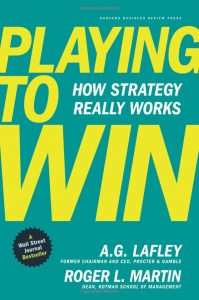 Lafley is a CEO, executive chairman, and author and Martin is a strategy advisor to CEO and author.
Lafley is a CEO, executive chairman, and author and Martin is a strategy advisor to CEO and author.
Jeff Hunter, whose book Patient- Centered Strategy is included on this list, recommended Playing to Win to me shortly after its publication and it was a light-bulb movement for me in really understanding how to create and deploy strategy. I recommend it to any leader seeking to really understand how to think about change management strategy – as a way to *win*…not just to play the game (to exist).
Here’s what I had to say about Playing to Win in an earlier article reflecting on how most organization approach “strategy” as “playing to play” rather than “playing to win”:
It seemed to me from working with and observing many companies across a variety of industries… that when they started “strategy deployment” that they weren’t actually deploying *strategy* (actions to provide differentiation and win with customers). One could remove the name of one organization and replace it with another and there would not be much difference. So many healthcare organizations were trying to be everything to everyone and “play to play”.
One of my most favorite questions to ask leaders to call out assumptions is one suggested by Lafely and Martin in Playing to Win: “What must be true?”
If you haven’t yet read this book and are a leader of strategy or organizational change management, put it on your list now!
Playing to Win: How Strategy Really Works
From the Publisher:
Are you just playing—or playing to win?
Strategy is not complex. But it is hard. It’s hard because it forces people and organizations to make specific choices about their future—something that doesn’t happen in most companies. This book shows how leaders in organizations of all sizes can guide everyday actions with larger strategic goals built around the clear, essential elements that determine business success—where to play and how to win.
The result is a playbook for winning. Lafley and Martin have created a set of five essential strategic choices that, when addressed in an integrated way, will move you ahead of your competitors. They are:
- What is our winning aspiration?
- Where will we play?
- How will we win?
- What capabilities must we have in place to win?
- What management systems are required to support our choices?
The stories of how P&G repeatedly won by applying this method clearly illustrate how deciding on a strategic approach—and then making the right choices to support it—makes the difference between just playing the game and actually winning.
Getting the Right Things Done by Pascal Dennis
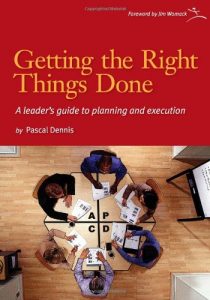 Engineer, author, and mentor to executives
Engineer, author, and mentor to executives
Getting the Right Things Done by Pascal Dennis is the second of my most recommended books on strategy deployment for anyone seeking to create a lean management system.
I first read Getting the Right Things Done as part of a two-day strategy class I attended that Pascal Dennis taught. It’s brilliant in sharing the simplicity of strategy development and deployment – or what is called hoshin kanri in Japanese. So many companies utilize overly complicated approaches to hoshin kanri or strategy deployment…Dennis brings us back to the principles and simplicity that underlie its successful application.
Dennis shares what he learned directly from his years of experience at Toyota, and his approach to strategy deployment mirrors what Isao Yoshino and I describe in Learning to Lead, Leading to Learn. A hybrid fictionalized story interspersed with practical lessons and examples, Getting the Right Things Done is a must read for anyone seeking to apply hoshin kanri (strategy deployment) in their organization.
Getting the Right Things Done: A Leader’s Guide to Planning and Execution
From the Publisher:
For companies to be competitive, leaders must engage people at all levels in order to focus their energy and enable them to apply lean principles to everything they do. Strategy deployment, called hoshin kanri by Toyota, has proven to be the most effective process for meeting this ongoing challenge. In his new book Getting the Right Things Done, author and LEI faculty member Pascal Dennis outlines the nuts and bolts of strategy deployment, answering two tough questions that ultimately can make or break a company’s lean transformation: * What kind of planning system is required to inspire meaningful company-wide continuous improvement? * How might we change existing mental models that do not support a culture of continuous improvement? Getting the Right Things Done demonstrates how strategy deployment can help leaders harness the full power of Lean. Organization leaders at all levels and the management teams who are responsible for strategy deployment will find this book especially insightful.
Turn the Ship Around! by L. David Marquet
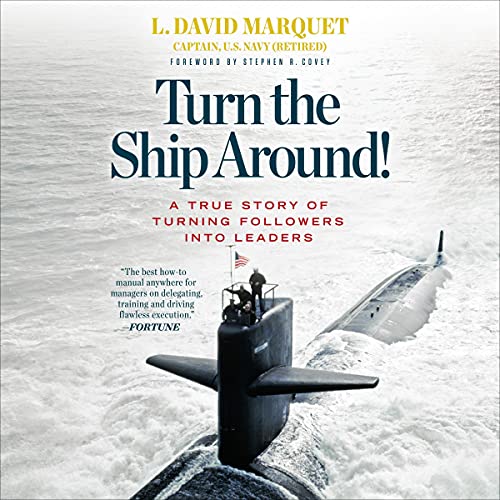 Turn the Ship Around! is a must- read for anyone in a leadership or people management role. I don’t know David Marquet personally, but this book is an essential read for how to create a people-centered learning culture. Marquet’s personal leadership story highlights the core shift that leaders at any level need to make – moving from expert to coach. Knowing when to tell, and when to ask. (And as I say, learn to “Break the Telling Habit”).
Turn the Ship Around! is a must- read for anyone in a leadership or people management role. I don’t know David Marquet personally, but this book is an essential read for how to create a people-centered learning culture. Marquet’s personal leadership story highlights the core shift that leaders at any level need to make – moving from expert to coach. Knowing when to tell, and when to ask. (And as I say, learn to “Break the Telling Habit”).
Marquet’s approach of “intent-based leadership” is closely aligned with both the Leading to Learn principles I share in Learning to Lead, Leading to Learn that leaders 1) set direction, 2) provide support to their people in figuring out how to get there, and 3) developing their own leadership capabilities at the same time, and my definition of intentional leadership: Intention = Heart + Direction ™. Intentional leadership is about knowing your purpose (heart) and aligning your actions (in that direction).
Turn the Ship Around!: A True Story of Turning Followers into Leaders
From the Publisher:
“Leadership should mean giving control rather than taking control and creating leaders rather than forging followers.” David Marquet, an experienced Navy officer, was used to giving orders. As newly appointed captain of the USS Santa Fe, a nuclear-powered submarine, he was responsible for more than a hundred sailors, deep in the sea.
Marquet acted like any other captain until, one day, he unknowingly gave an impossible order, and his crew tried to follow it anyway. When he asked why the order wasn’t challenged, the answer was “Because you told me to.” Marquet realized he was leading in a culture of followers, and they were all in danger unless they fundamentally changed the way they did things. That’s when Marquet took matters into his own hands and pushed for leadership at every level.
Turn the Ship Around! is the true story of how the Santa Fe skyrocketed from worst to first in the fleet by challenging the U.S. Navy’s traditional leader-follower approach. Struggling against his own instincts to take control, he instead achieved the vastly more powerful model of giving control. Before long, each member of Marquet’s crew became a leader and assumed responsibility for everything he did, from clerical tasks to crucial combat decisions. The crew became fully engaged, contributing their full intellectual capacity every day, and the Santa Fe started winning awards and promoting a highly disproportionate number of officers to submarine command.
No matter your business or position, you can apply Marquet’s radical guidelines to turn your own ship around. The payoff: a workplace where everyone around you is taking responsibility for their actions, where people are healthier and happier, where everyone is a leader.
The last word on books on culture, organizational change, and strategy
I truly hope that you learn as much from these books as I have.
I also hope that they help you to grow your Chain of Learning as you share what you learn from these books on culture, organizational change, and strategy.
If you do read them, please drop me a note and let me know which ones you read and what you think of them.
Each one of these books has played an important role in my learning journey. I hope that they also help to show you the way.
If you’d like to read my book, Learning to Lead, Leading to Learn, you can get your copy here.
Book Recommendation Series Overview
This is just one article of several that I’ve put together for you to deepen your Chain of Learning about lean, problem-solving, culture, strategy, and more.
This article contains a list of books that explores how the principles of lean management are applied across a variety of industries.
Here is the full list of my book recommendation series:
- 10 Top Books on Lean Management, Lean Production, and Toyota History
- 10 Top Books on Coaching and Problem-Solving
- 10 Top Books on Culture, Organizational Change, and Strategy



